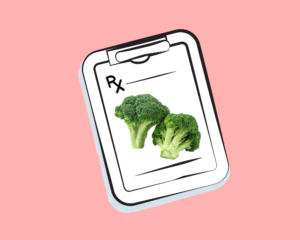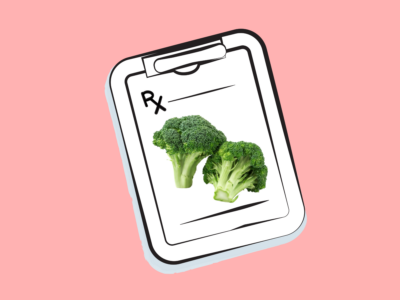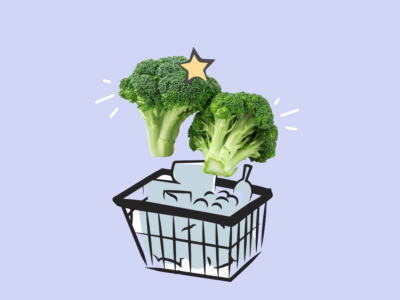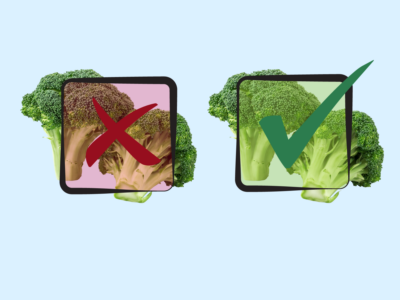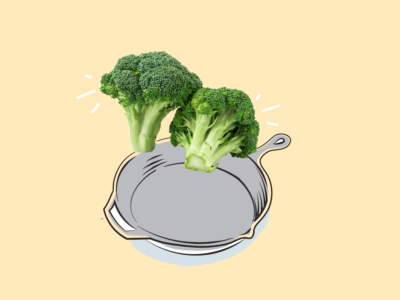Table of Contents[Hide][Show]
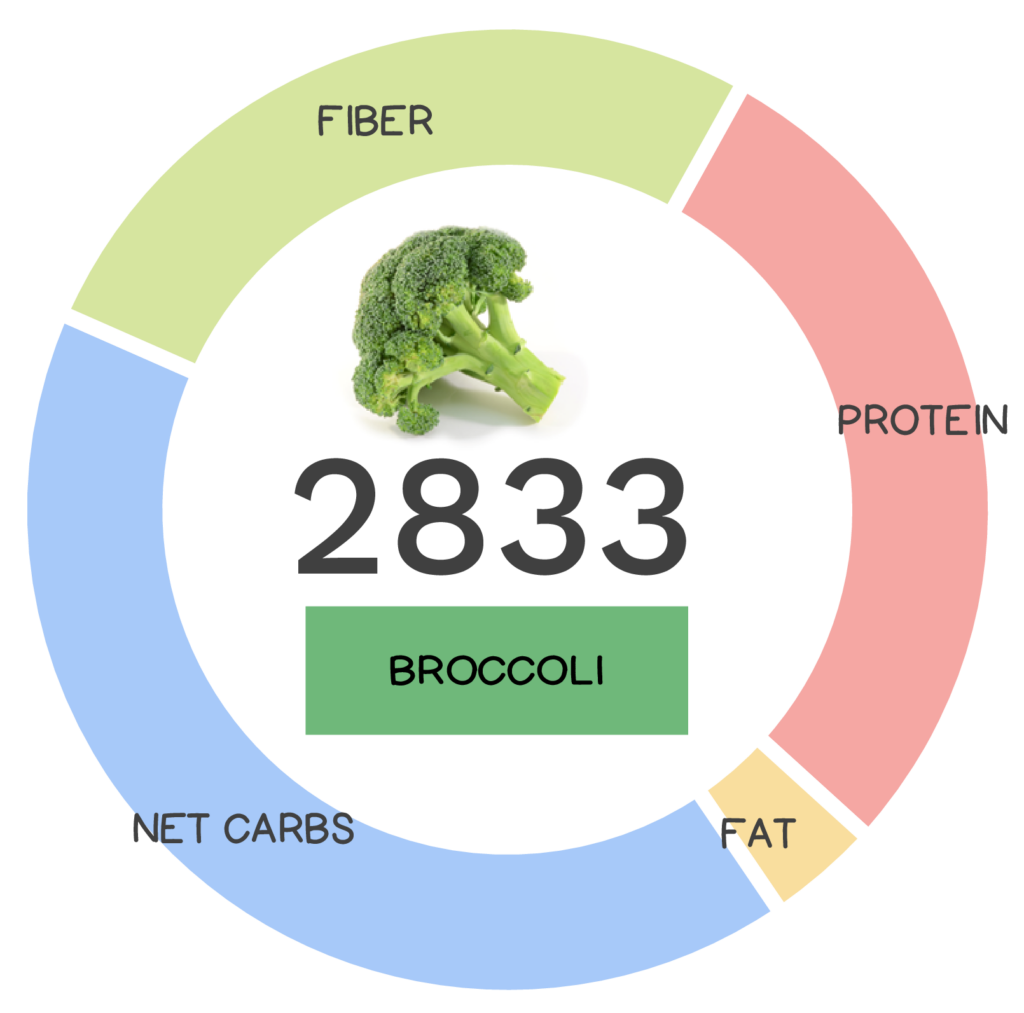
Love it or hate it, most of us are familiar with the fractal-esque mini green tree-resembling vegetable called broccoli. In the USA, broccoli is the 5th best-selling vegetable (after potatoes, tomatoes, onions and carrots). And yet, Americans only consume an average of 6 pounds of fresh broccoli per year. Looking for inspiration to up your broccoli game? You’ve come to the right place!
Broccoli is a member of the cruciferous vegetable family, along with cauliflower, Brussels sprouts, collard greens, kohlrabi, and kale.
Broccoli is a large green plant with a flowering head that is a member of the cabbage plant family, Brassicaceae, also called Brassicas or cruciferous vegetables, and its scientific name is Brassica oleracea. Other members of the cruciferous vegetable family include cauliflower, Brussels sprouts, collard greens, kohlrabi, and kale.
Broccoli is derived from a species of wild cabbage and originated in Italy more than 2,000 years ago! The word broccoli is an Italian word from the Latin brachium, meaning an arm or branch. Broccoli was brought to North America in the 19th century by Italian immigrants. It is known as the “crown jewel of nutrition” because it is packed with nutrients including vitamins, minerals, phytonutrients, antioxidants and fiber resulting in its exceptional health benefits.
Learn What Foods to *ADD* to Your Diet
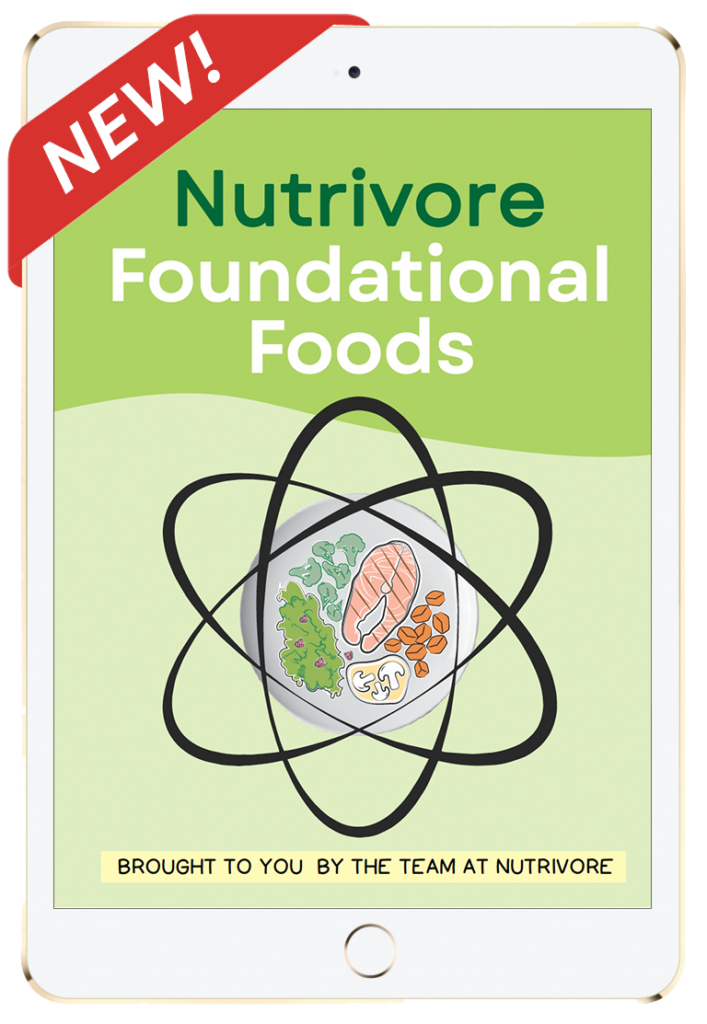
Nutrivore Foundational Foods
Learn what makes the 12 Nutrivore foundational food families nutritionally unique, their health benefits, which options are the most nutrient dense, how much of them to eat, plus various fun facts, practical pointers, and busting of common myths.
This very helpful resource will introduce you to new foods and expand your nutrition knowledge, making food choices easier!
Buy now for instant digital access.
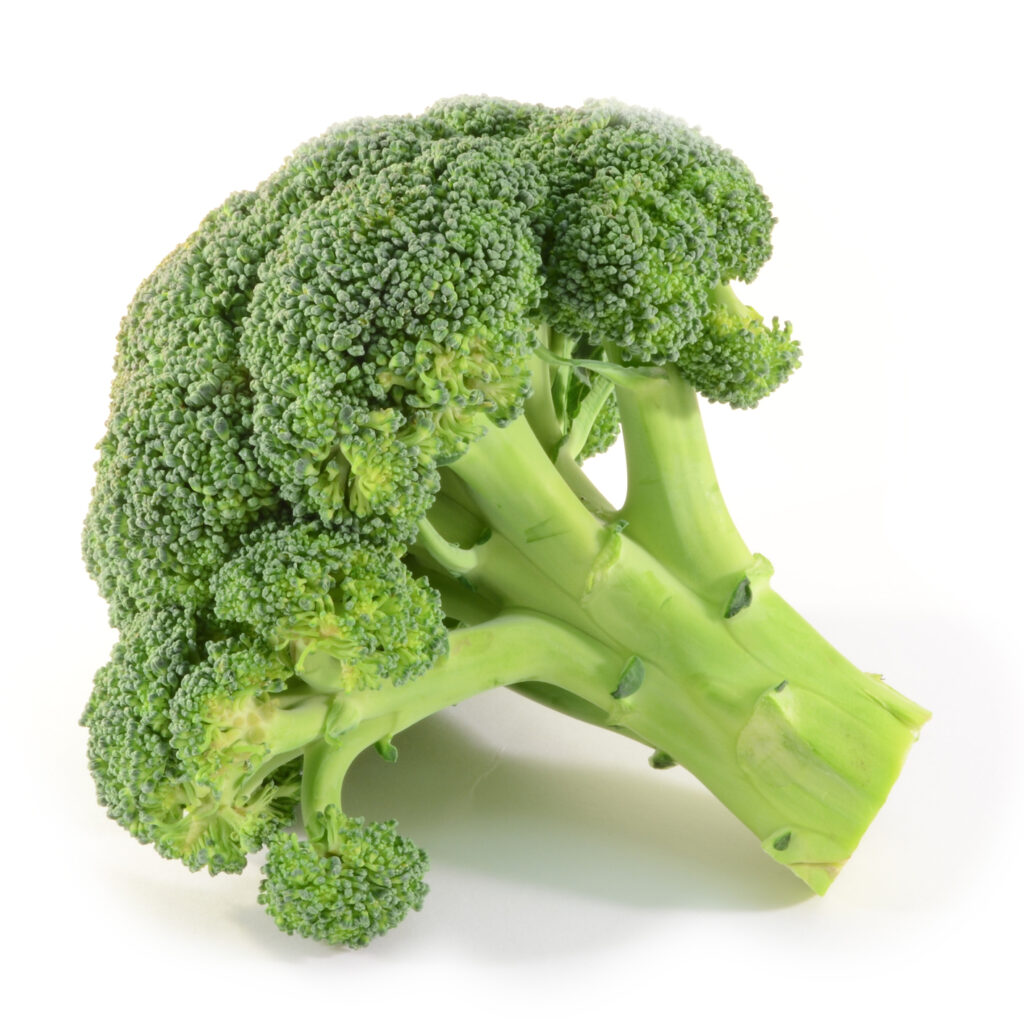
Nutrivore Score for Broccoli-2833
Broccoli has an impressive Nutrivore Score of 2833, which makes it a super nutrient-dense food! Plus, it’s a low-carb and low-calorie-density food; the calorie count of broccoli is just 31 calories per cup!
Per serving, broccoli is a best source (>50% daily value) of glucosinolates, vitamin C, and vitamin K; an excellent source (20-50% daily value) of polyphenols and vitamin B7 (biotin); and is a good source (10-20% daily value) of CoQ10, vitamin B5 (pantothenic acid), vitamin B9 (folate), and carotenoids, including beta-carotene, lutein and zeaxanthin!
Want to Browse the Entire Database?
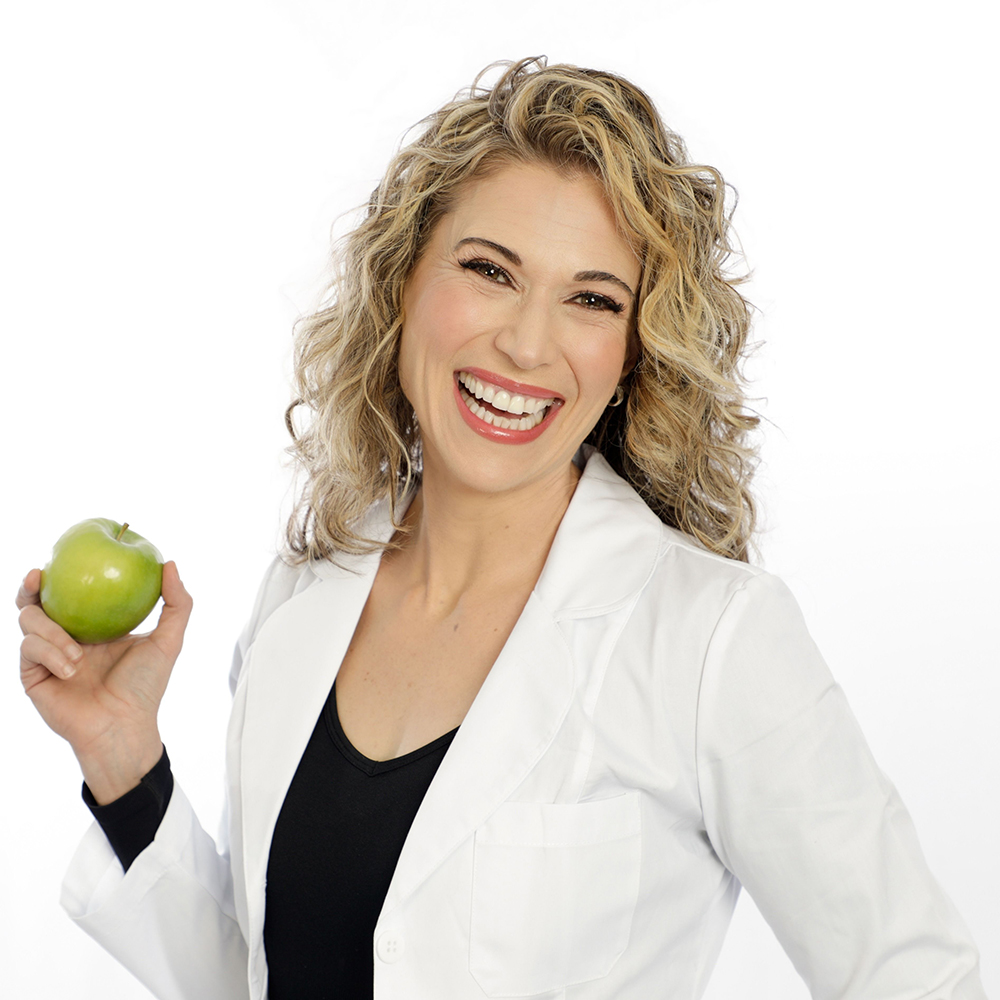
If you’re interested in browsing the entire Nutrivore Score Database of 8,000 foods, you can do so in Patreon!
Plus every month, you’ll gain exclusive and early access to a variety of resources, including a weekly video podcast, a new e-book in a series, nutrient fun factsheet, and more! Sign up now and also get 5 free Nutrivore guides as a welcome gift! Win-win-win!
Broccoli Nutrition Facts
One serving of broccoli is standardized to 1 cup of chopped raw broccoli florets and stems, or about 91 grams (3.2 ounces). When you cook broccoli, it loses some volume: one cup raw broccoli is equivalent to a little over 1/2 cup boiled broccoli.
A typical portion of broccoli is one stalk (150 grams), which is more than 1.5 servings! Bonus!!
Broccoli Nutrition Facts per Serving
| Broccoli, raw | Nutrivore Score: 2833 | Nutrient Density: Super! |
|---|---|---|
| Serving Size: 1 cup (91 grams) | Protein: 2.6 grams | Net Carbohydrates: 3.7 grams |
| Calories: 31 | Total Fat: 0.3 grams | Dietary Fiber: 2.4 grams |
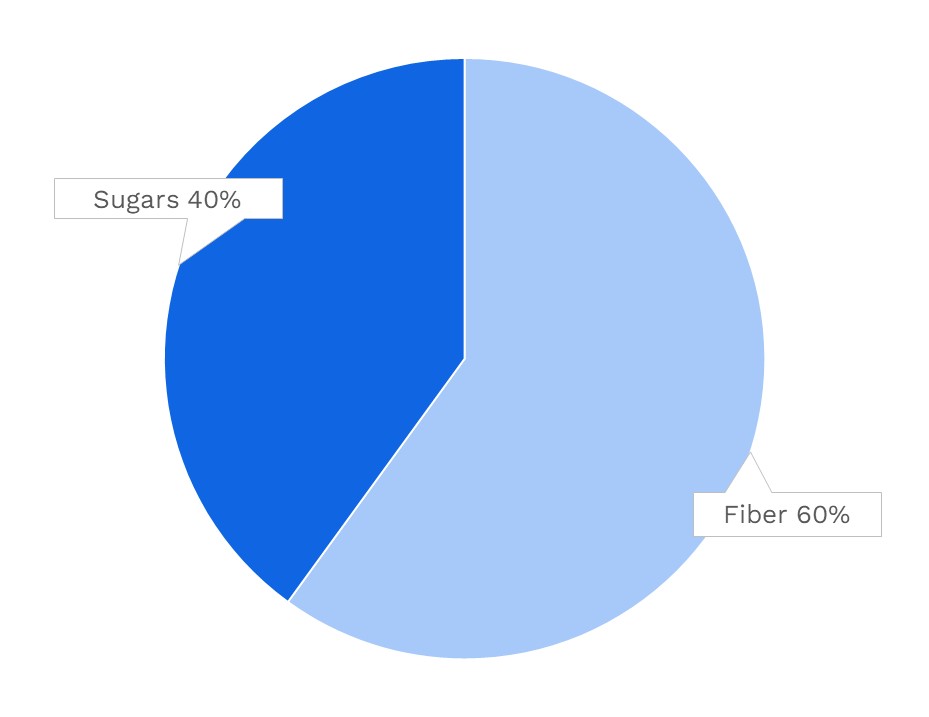

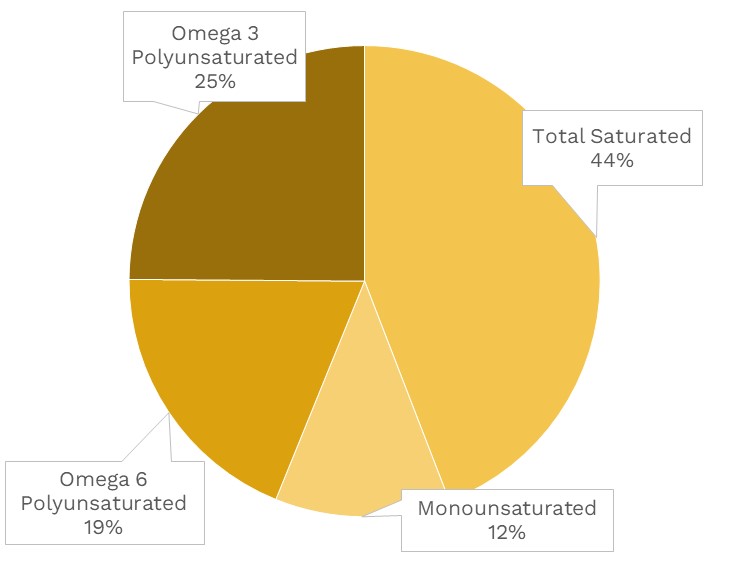
| VITAMINS | ||
|---|---|---|
| Vitamin A | 28.2 μg RAE | 3% DV |
| Vitamin B1 (Thiamin) | 64.6 μg | 5% DV |
| Vitamin B2 (Riboflavin) | 106.5 μg | 8% DV |
| Vitamin B3 (Niacin) | 0.6 mg | 4% DV |
| Vitamin B5 (Pantothenic Acid) | 0.5 mg | 10% DV |
| Vitamin B6 (Pyridoxine) | 159.3 μg | 9% DV |
| Vitamin B7 (Biotin) | 8.5 μg | 28% DV |
| Vitamin B9 (Folate) | 57.3 μg | 14% DV |
| Vitamin B12 (Cobalamin) | 0.0 μg | 0% DV |
| Vitamin C | 81.2 mg | 90% DV |
| Vitamin D (D2 + D3) | 0.0 μg | 0% DV |
| Vitamin E | 0.9 mg | 6% DV |
| Vitamin K | 92.5 μg | 77% DV |
| Choline | 17.0 mg | 3% DV |
| Myo-Inositol | 27.3 mg | ~ |
| CoQ10 | 0.8 mg | ~ |
| FUNCTIONAL FATS | ||
|---|---|---|
| MUFA | 0.0 g | 0% DV |
| ALA | 57.3 mg | 4% DV |
| EPA + DHA | 0.0 mg | 0% DV |
| CLA | ~ | ~ |
| Linoleic Acid | 0.0 g | 0% DV |
| MCT’s | 0.0 g | ~ |
| MINERALS | ||
|---|---|---|
| Calcium | 42.8 mg | 3% DV |
| Copper | 44.6 μg | 5% DV |
| Iodine | ~ | ~ |
| Iron | 0.7 mg | 4% DV |
| Magnesium | 19.1 mg | 5% DV |
| Manganese | 191.1 μg | 8% DV |
| Phosphorus | 60.1 mg | 5% DV |
| Potassium | 287.6 mg | 6% DV |
| Selenium | 2.3 μg | 4% DV |
| Sodium | 30.0 mg | 1% DV |
| Zinc | 0.4 mg | 3% DV |
| PHYTONUTRIENTS | ||
|---|---|---|
| Carotenoids | 1628.9 μg | ~ |
| Polyphenols | 306.7 mg | ~ |
| Phytosterols | 37.2 mg | ~ |
| Glucosinolates | 298.5 mg | ~ |
| Thiosulfinates | ~ | ~ |
| Betalains | ~ | ~ |
| AMINO ACIDS & PEPTIDES | ||
|---|---|---|
| Taurine | ~ | ~ |
| Ergothioneine | 0.0 mg | ~ |
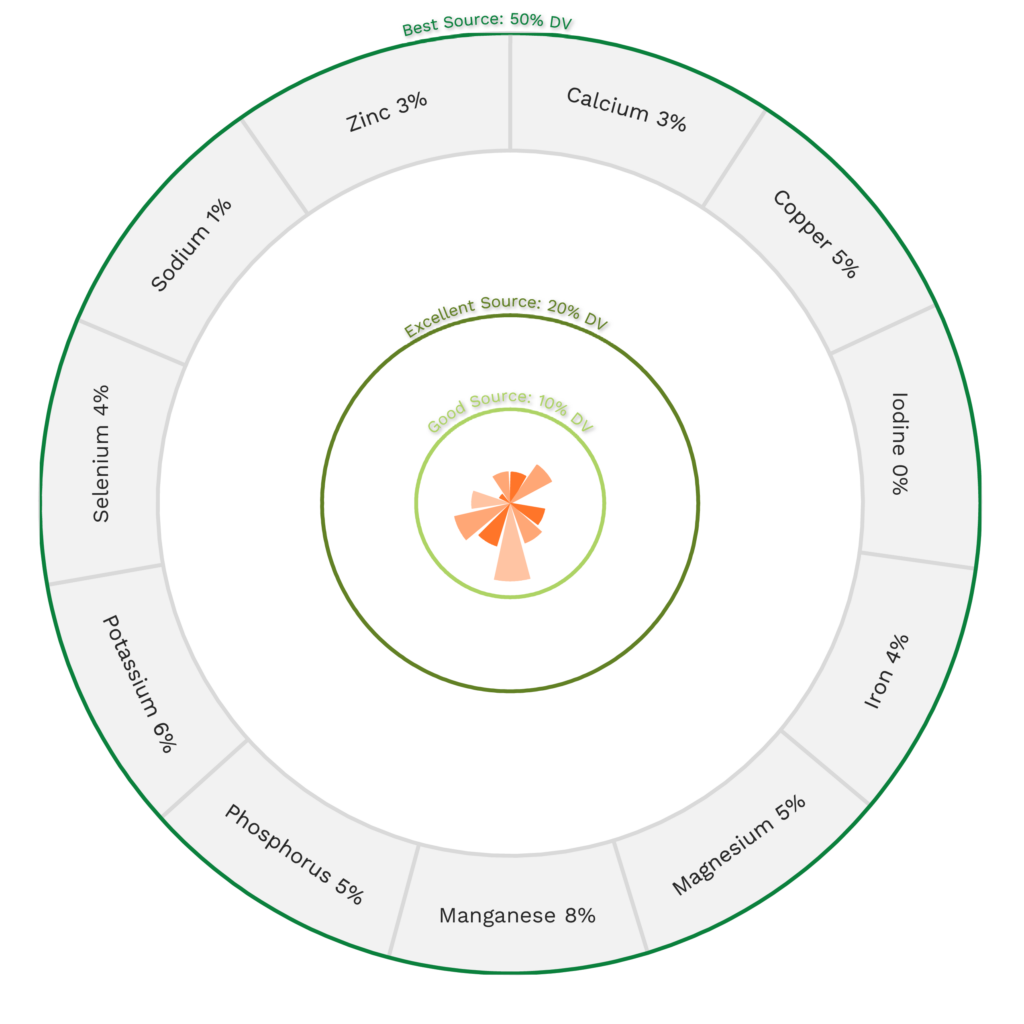
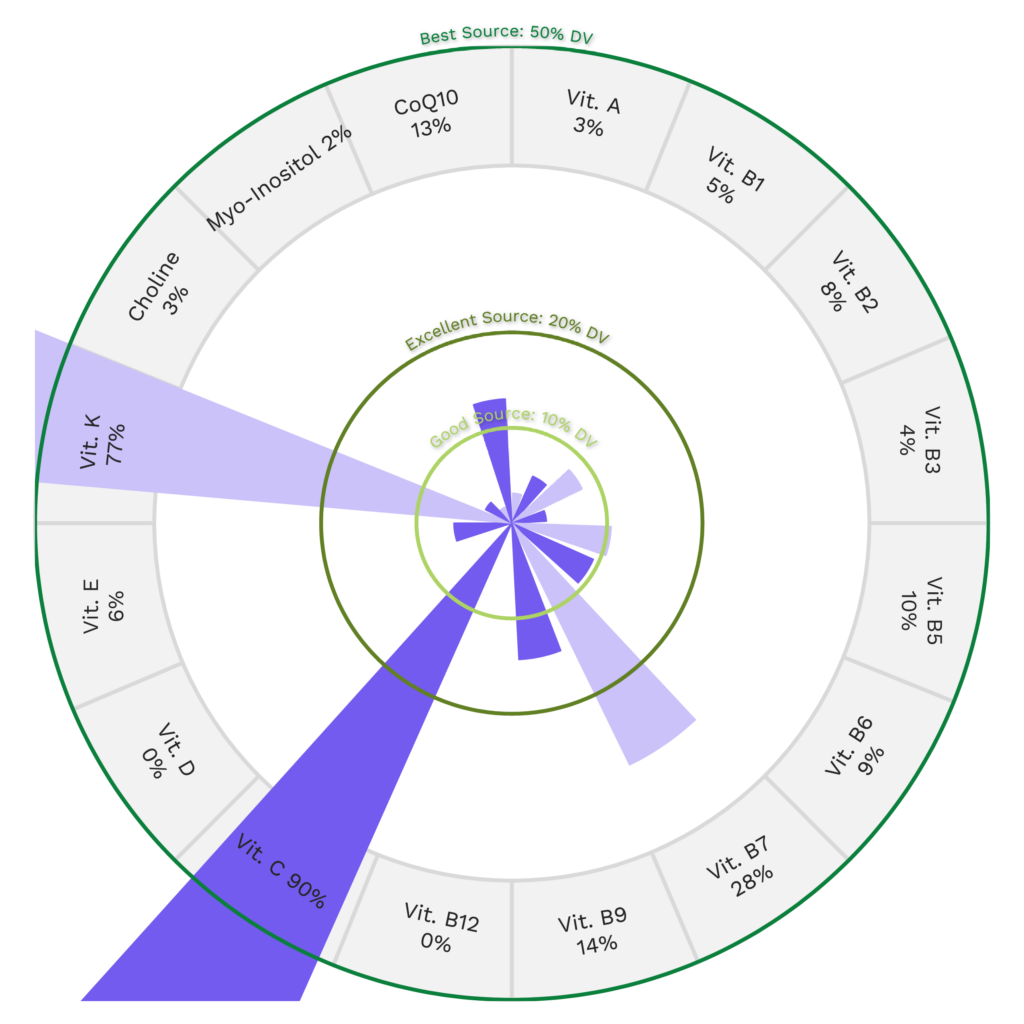
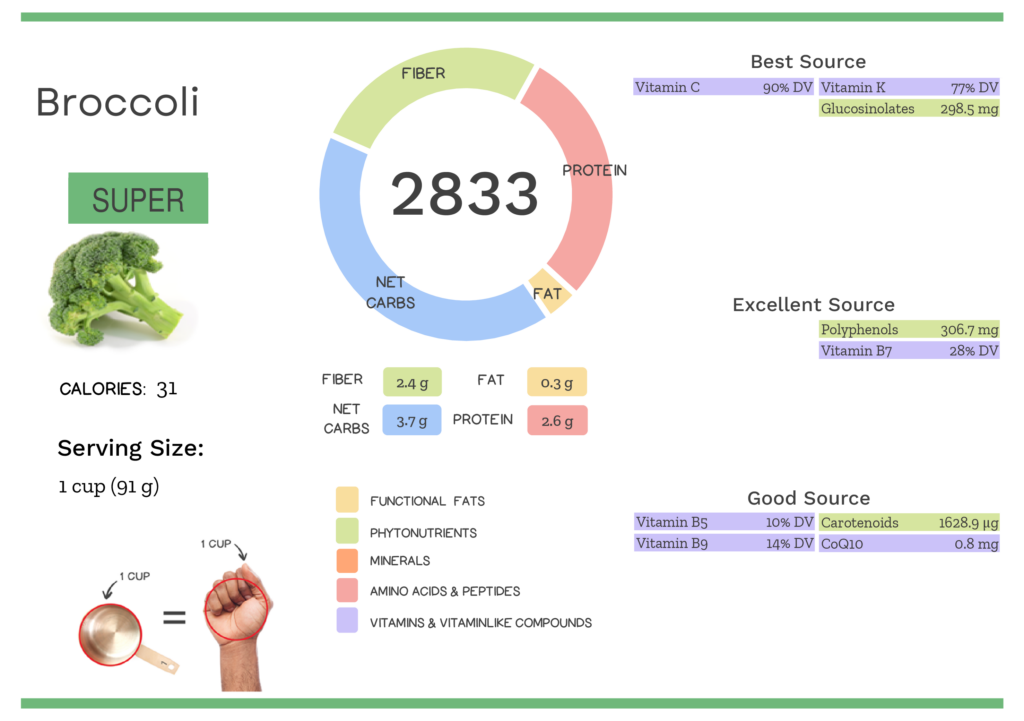
Ditch Diets. Embrace Nutrients. Start with this FREE Guide.
Sign up for the free Nutrivore Newsletter, your weekly, science-backed guide to improving health through nutrient-rich foods — without dieting harder —and get the Beginner’s Guide to Nutrivore delivered straight to your inbox!

Broccoli Nutrition Varies With Cooking and Processing
The Nutrivore Score for broccoli varies depending on processing and the method of preparation. Conveniently, frozen broccoli is available year-round at the grocery store.
| NUTRIVORE SCORE | |
|---|---|
| Broccoli, cooked, boiled, drained, with salt | 2914 |
| Broccoli, cooked, boiled, drained, without salt | 2914 |
| Broccoli, frozen, chopped, cooked, boiled, drained, with salt | 2718 |
| Broccoli, frozen, chopped, cooked, boiled, drained, without salt | 2718 |
| Broccoli, frozen, chopped, unprepared | 2925 |
| Broccoli, frozen, spears, cooked, boiled, drained, with salt | 2792 |
| Broccoli, frozen, spears, cooked, boiled, drained, without salt | 2738 |
| Broccoli, frozen, spears, unprepared | 2960 |
| Broccoli, raw | 2833 |
Broccoli Stems and Leaves Are Nutritious, Too!
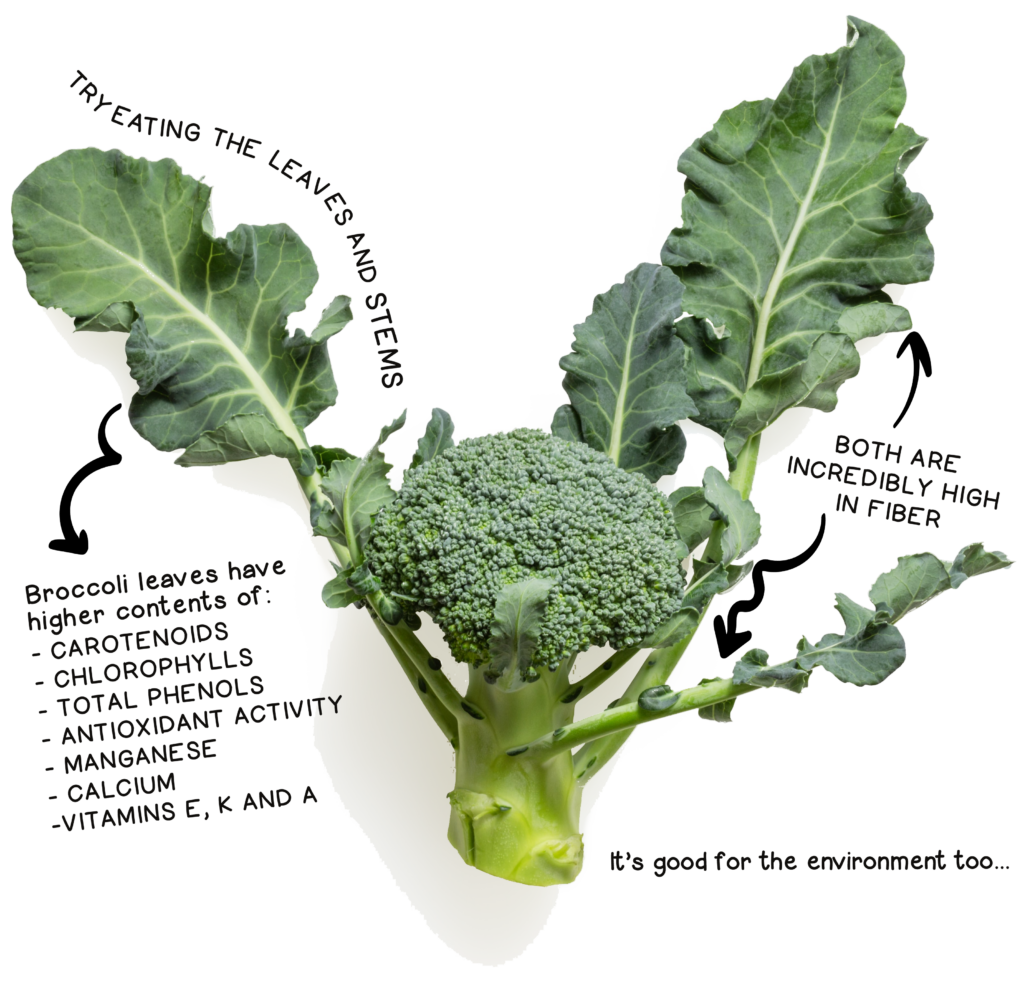
While we typically only consume broccoli florets, which accounts for about 15% of the broccoli plant, both the stem (21%) and leaves (47%) are also packed with nutrition!
In fact, broccoli leaves have higher contents of carotenoids, chlorophylls, total phenols, antioxidant activity, manganese, calcium, and vitamins E, K and A as compared to florets. The leaves also have a high content of dietary fiber comparable to levels found in many other vegetables and fiber rich foods. In fact leaves have more total dietary fiber, as a percentage of dried weight, as that found in carrots and apples!
A 100-gram of broccoli leaves contains 2.3 grams of fiber and has more than 100% of your RDA of vitamins C, A and K (phylloquinone), 10% manganese, 19.9% vitamin E, plus calcium.
Broccoli stems contain large amounts of insoluble fiber and the highest levels of most sugars (fructose, glucose, sucrose, and maltose) and sodium as compared to florets and leaves. They also provide comparable levels of calcium, magnesium, phosphorus, potassium, manganese, vitamins C, A and B vitamins to florets, as well as 20-27% RDA for vitamin K (100-gram portion).
Not surprisingly, this means the Nutrivore Score varies depending on the portion of the plant being consumed.
| NUTRIVORE SCORE | |
|---|---|
| Broccoli, flower clusters, raw | 8332 |
| Broccoli, leaves, raw | 8332 |
| Broccoli, raw | 2833 |
| Broccoli, stalks, raw | 8122 |
Not only does consumption of both the stem and leaves of broccoli clearly result in health benefits but it would lead to increased productivity and sustainability of the world’s broccoli crop – a win for the environment too! So next time you’re cooking broccoli consider adding the leaves and stem to your dinner plate as well.
Surprised that broccoli is THAT nutritious? Maybe your friends will be too!
Health Benefits of Broccoli Nutrients
Let’s take a closer look at all of the best and excellent source of nutrients found in a 1-cup serving of broccoli and see how they benefit our health.
Broccoli Provides 90% DV Vitamin C
Broccoli is a particularly awesome source of vitamin C, providing 90% of the daily value per 1-cup serving.
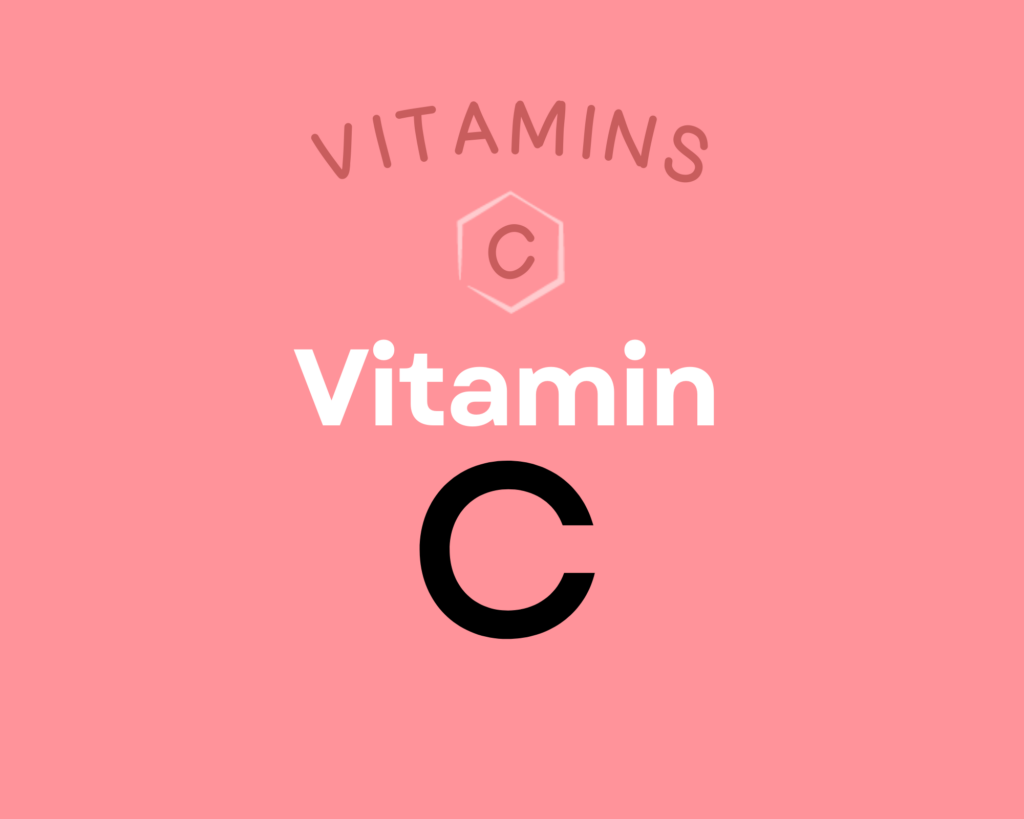
Vitamin C is a water-soluble vitamin that has powerful antioxidant properties (meaning it can help combat oxidative damage from free radicals and reactive oxygen species) and that serves as an enzyme cofactor (meaning it’s needed for enzymes to do their job, for example vitamin C is necessary for collagen synthesis, which is essential for bones, joints, teeth, blood vessels, skin and eyes) and playing important roles in immune system and skin health. Higher intakes of vitamin C are linked to reduced risk of heart disease, some forms of cancer, type 2 diabetes, cataracts, age-related macular degeneration, and gout. Vitamin C can also help regulate the stress response and reduce anxiety, and there’s preliminary evidence that it may also help prevent Alzheimer’s disease. Learn more about vitamin C here.
Broccoli Provides 77% DV Vitamin K
Broccoli is also a particularly valuable source of vitamin K, providing 77% of the daily value per 1-cup serving.
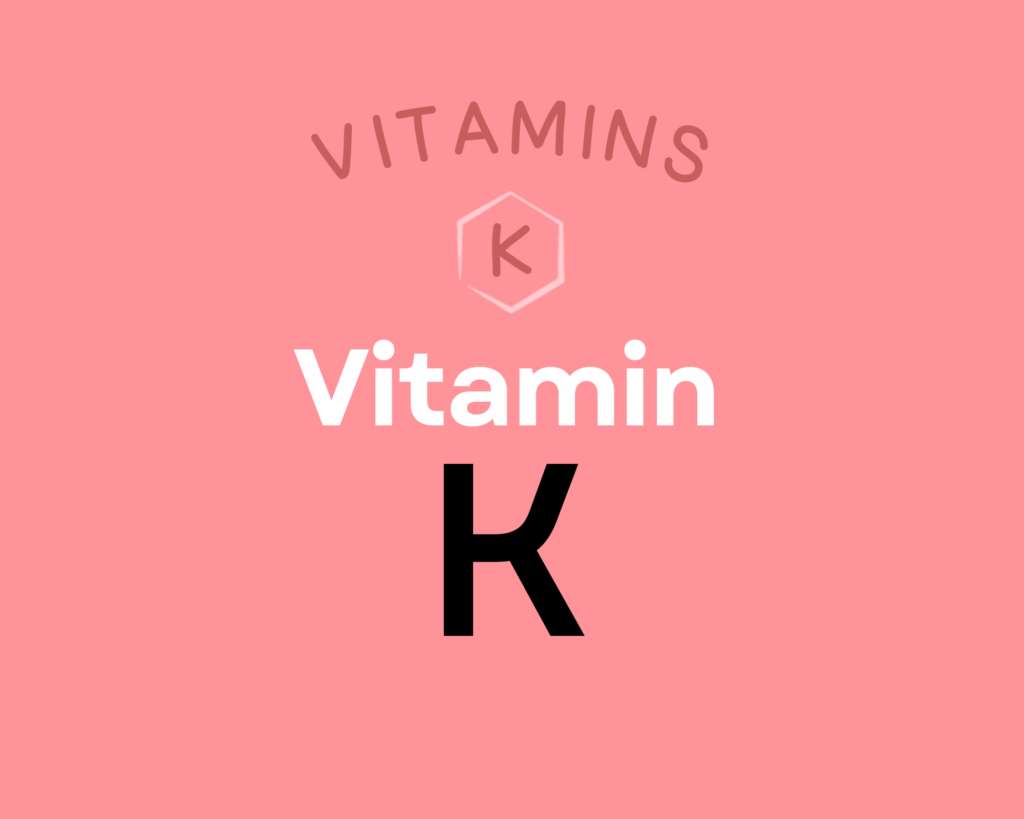
Vitamin K is actually a group of fat-soluble vitamins with a similar molecular structure, existing as K1, multiple isoforms of K2, and the synthetic form K3. This nutrient plays a vital role in coagulation, due to serving as a cofactor for proteins needed for blood clotting; it’s also essential for bone metabolism, cellular function, and the prevention of soft tissue calcification. Getting enough vitamin K2 can help protect against cardiovascular disease, may improve bone mineral density and skeletal health, and may even support endocrine function and brain health; there’s also some limited evidence it has anti-cancer and anti-inflammatory properties. Learn more about vitamin K here.
Broccoli Provides 298.5 mg of Glucosinolates
Broccoli is an outstanding source of glucosinolates, providing 298.5 mg of glucosinolates per 1-cup serving!
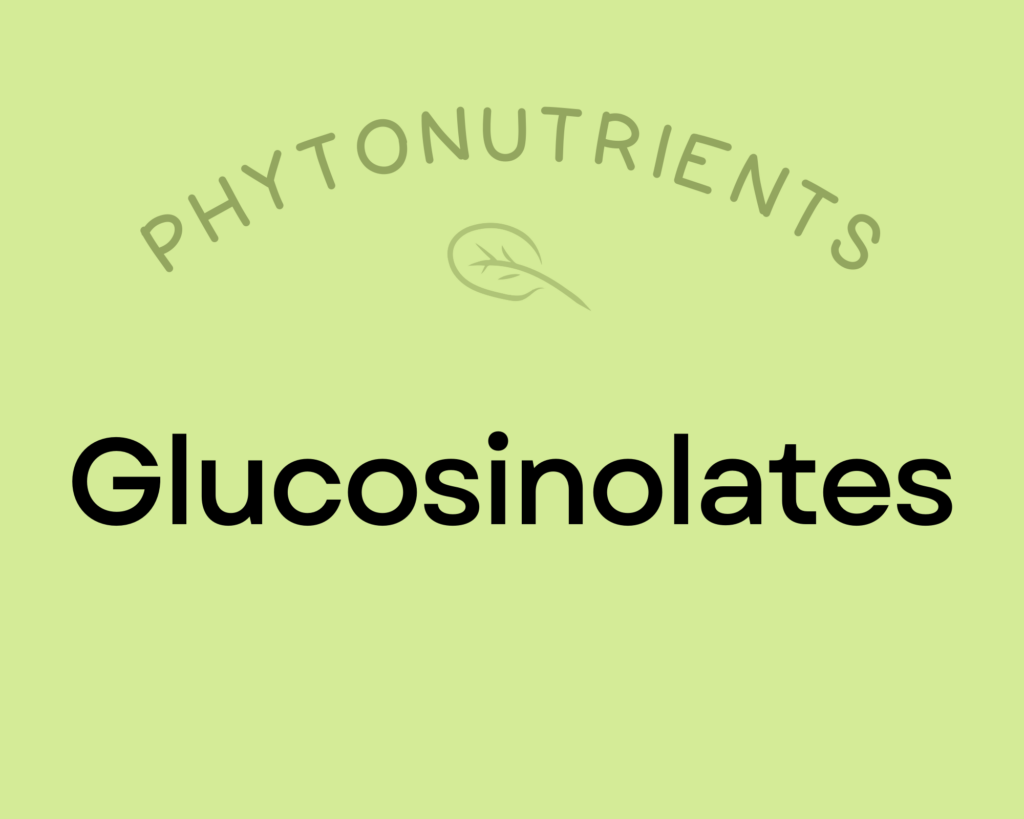
Glucosinolates are well-studied sulfur-containing compounds which break down into bioactive isothiocyanates and indoles when vegetables are damaged (via chewing, cutting, or other processing).
Isothiocyanates (like sulforaphane) are absolute rock stars as far as human health is concerned! Research spanning human epidemiology, animal models, and in vitro experiments show that dietary isothiocyanates are inversely associated with bladder cancer, lung cancer, colon cancer, breast cancer, and pancreatic cancer; some evidence also suggests they may be able to improve ventricular function following heart attacks.
Indoles also have powerful cancer prevention benefits through multiple mechanisms that include modulation of phases I and II detoxification enzymes, regulation of cell cycle arrest, control of cell growth, induction of apoptosis, antioxidant activity, anti-angiogenic effects, and epigenetic regulation. Indole-3-carbinol breaks down into 3,3′-Diindolylmethane (DIM), which is known for its anti-inflammatory, immune system modulating, cancer prevention and estrogen metabolism benefits.
Learn more about glucosinolates here.
For more on how the glucosinolates in broccoli improve heart health, bone health and type 2 diabetes, support liver detoxification, and lower risk of cancer and neurodegenerative disease, see Health Benefit of Broccoli.
Health Benefits of Broccoli
Eating broccoli results in an overall improvement to general health, and reduces risk of cancer, cardiovascular disease, and type 2 diabetes, in addition to other health benefits!
Broccoli Provides 306.7 mg of Polyphenols
Broccoli is an excellent source of polyphenols, providing 306.7 mg polyphenols per 1-cup serving.
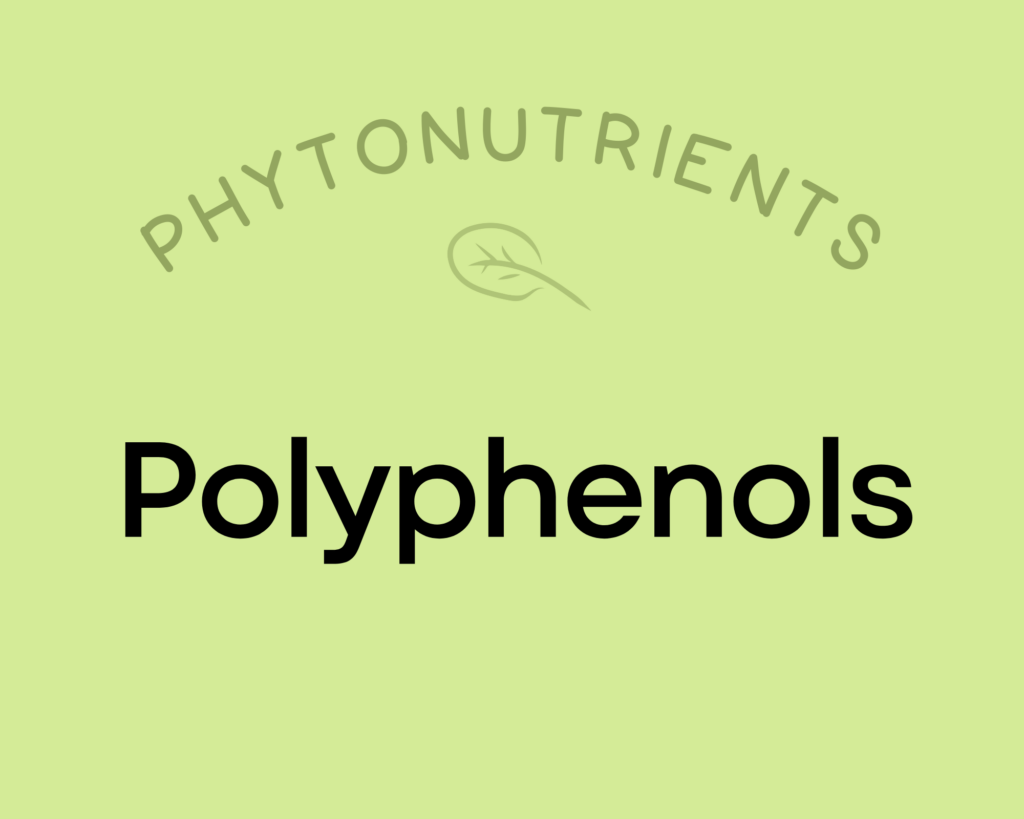
Polyphenols play a huge role in protecting against cancer, heart disease, diabetes, asthma, osteoporosis, neurodegenerative diseases, and other conditions associated with oxidative stress. In fact, a major reason foods like red wine and olive oil (as well as diets rich in both, such as the Mediterranean diet) show up as so beneficial may be due to their high polyphenol content! Along with chronic diseases, supplementing with polyphenols has been shown to protect against infections and reduce the signs of aging. Polyphenols exert their most potent effects by acting as antioxidants—preventing cellular damage by neutralizing hazardous oxygen radicals and improving cellular health as a result (which, in turn, benefits virtually every system in the body). As a result of their antioxidant properties, polyphenols also boost the immune system and protect against both chronic and acute diseases. In addition, polyphenols can help regulate enzyme function, stimulate cell receptors, modulate the functions of inflammatory cells (including T and B lymphocytes, macrophages, platelets, and natural killer cells), alter adhesion molecule expression, affect nerve cells and cardiac muscle cells, and exert antiviral effects. Learn more about polyphenols here.
Broccoli Provides 28% DV Vitamin B7 (Biotin)
Broccoli is also an excellent source of vitamin B7 (biotin), providing 28% of the daily value per 1-cup serving.
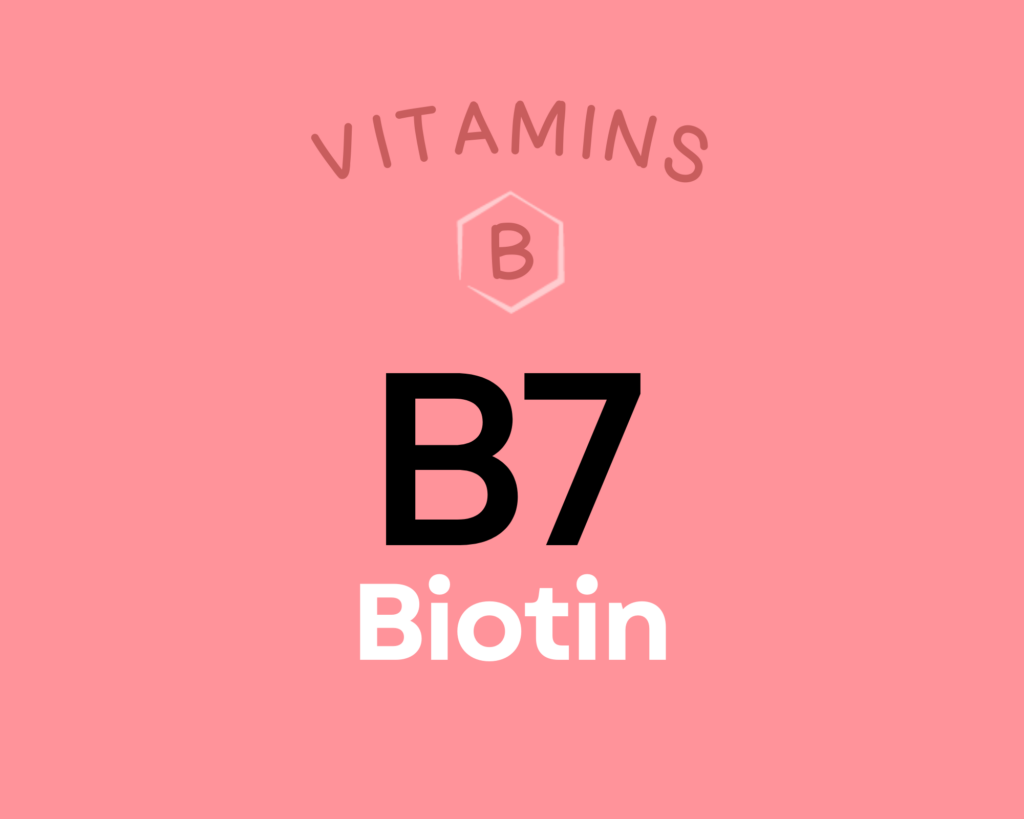
Biotin is a water-soluble B vitamin, also known as vitamin B7. Like other B vitamins, it plays an important role in energy metabolism (serving as a coenzyme for five carboxylase enzymes), neurotransmitter production, cellular function, and the function of various organs. Getting enough biotin can help support healthy nail and hair growth. It’s also particularly important during pregnancy, with low intakes increasing the risk of premature delivery and birth defects. There’s even some evidence biotin can benefit diabetics and reduce functional disabilities in people with multiple sclerosis. Learn more about biotin here.
Learn What Foods Are the Best Sources of Every Nutrient

The Top 25 Foods for Every Nutrient
The Top 25 Foods for Every Nutrient e-book is a well-organized, easy-to-use, grocery store-friendly guide to help you choose foods that fit your needs of 43 important nutrients while creating a balanced nutrient-dense diet.
Get two “Top 25” food lists for each nutrient, plus you’ll find RDA charts for everyone, informative visuals, fun facts, serving sizes and the 58 foods that are Nutrient Super Stars!
Buy now for instant digital access.
How Much Broccoli Should We Eat per Day?
You know the old aphorism, a Brassica vegetable a day keeps the doctor away! Wait, that’s not how it goes? It should be!
Every serving of fresh, whole vegetables or fruit we eat daily reduces the risk of all-cause mortality by 5% to 8%, with the greatest risk reduction seen when we consume five or more servings per day. In fact, consuming 800 grams of vegetables and fruits daily reduces all-cause mortality by 31% compared to eating less than 40 grams daily. A 2017 meta-analysis showed that 2.24 million deaths from cardiovascular disease, 660,000 deaths from cancer, and 7.8 million deaths from all causes could be avoided globally each year if everyone consumed 800 grams of veggies and fruits every day.
Eating vegetables and fruit in abundance lowers risk of cancer, cardiovascular disease, type 2 diabetes, obesity, chronic kidney disease, osteoporosis and bone fragility fractures (including hip fracture), cognitive impairment and dementia (including Alzheimer’s disease), neurodegenerative diseases, asthma, allergies, chronic obstructive pulmonary disease, age-related macular degeneration, cataracts, glaucoma, depression, ulcerative colitis and Crohn’s disease, rheumatoid arthritis, inflammatory polyarthritis, non-alcoholic fatty liver disease, acne, seborrheic dermatitis, and lowers markers of inflammation. Learn more in Importance of Vegetables and Fruit.
Covering half of your plate with a variety of vegetables (and three quarters of your plate if your starchy food is a root vegetable or winter squash) at each meal is a simple way to easily achieve the goal of 5 or more servings of vegetables daily.
While it’s always best to mix up the veggies you eat day to day (aiming for a wide variety of different vegetables and fruits throughout the week), researchers have conducted studies where participants eat up to 500 grams (over a pound!) of broccoli daily and shown health benefits! So, there doesn’t seem to be an upper limit in terms of how much broccoli to eat.
Everything You Need to Jump into Nutrivore TODAY!

Nutrivore Quickstart Guide
The Nutrivore Quickstart Guide e-book explains why and how to eat a Nutrivore diet, introduces the Nutrivore Score, gives a comprehensive tour of the full range of essential and important nutrients!
Plus, you’ll find the Top 100 Nutrivore Score Foods, analysis of food groups, practical tips to increase the nutrient density of your diet, and look-up tables for the Nutrivore Score of over 700 foods.
Buy now for instant digital access.
Citations
Expand to see all scientific references for this article.
Clements RS Jr, Darnell B. Myo-inositol content of common foods: development of a high-myo-inositol diet. Am J Clin Nutr. 1980 Sep;33(9):1954-67. doi: 10.1093/ajcn/33.9.1954. PMID: 7416064.
Ey J, Schömig E, Taubert D. Dietary sources and antioxidant effects of ergothioneine. J Agric Food Chem. 2007 Aug 8;55(16):6466-74. doi: 10.1021/jf071328f. Epub 2007 Jul 6. PMID: 17616140.
Han JH, Yang YX, Feng MY. Contents of phytosterols in vegetables and fruits commonly consumed in China. Biomed Environ Sci. 2008 Dec;21(6):449-53. doi: 10.1016/S0895-3988(09)60001-5. PMID: 19263798.
Phenol-Explorer: Broccoli, raw
Possenti, M, Baima S, Raffo A, Durazzo A, Giusti AM, Natella F. Glucosinolates in Food. Glucosinolates. 2016. 1-46. doi: 10.1007/978-3-319-26479-0_4-1.
Pravst I, Zmitek K, Zmitek J. Coenzyme Q10 contents in foods and fortification strategies. Crit Rev Food Sci Nutr. 2010 Apr;50(4):269-80. doi: 10.1080/10408390902773037. PMID: 20301015.
USDA Food Central Database: Broccoli, raw
Watanabe T, Kioka M, Fukushima A, Morimoto M, Sawamura H. Biotin content table of select foods and biotin intake in Japanese. Int J Anal Bio-Sci. 2014. Vol 2(4):109-125.



